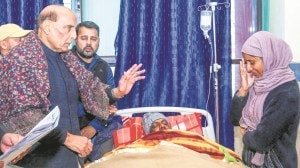- India
- International
World TB day: How newer oral drugs helped Mumbai fashion designer recover with fewer side effects
Thirty one-year-old recalls how the longer oral drug regimen marked a turning point in her battle against the disease
 Laxmi battled drug-resistant TB. The Global TB Report 2023 ranks India as one of the top high-burden countries for multi-drug resistant/rifampicin-resistant tuberculosis (MDR/RR-TB), with 27 per cent of the world’s drug-resistant cases (Express Photo)
Laxmi battled drug-resistant TB. The Global TB Report 2023 ranks India as one of the top high-burden countries for multi-drug resistant/rifampicin-resistant tuberculosis (MDR/RR-TB), with 27 per cent of the world’s drug-resistant cases (Express Photo)At 31, Laxmi Asrani has battled drug-resistant tuberculosis, the kind that’s compounding India’s disease burden, twice. Once when she lost her father to it and the other when she herself contracted it. Now, after two years of therapy and persistence, this young fashion designer from Mumbai has recovered and has a double purpose — that of launching her women’s apparel line and opening an NGO for educating TB patients.
Just back from Paris, Laxmi 2.0, as she has rechristened herself, weighs 73 kg and attributes her recovery to a new regimen of drugs recommended under the National TB Elimination Programme. “This shift to an oral, longer regimen with newer drugs instead of injectables marked a turning point in her battle against the disease. Not only did it facilitate her recovery, it minimised the adverse effects associated with the conventional treatment approach that she had chosen initially,” says her pulmonologist, Dr Vikas Oswal.
These newer drugs are powering India’s arsenal against TB, which it seeks to eliminate by 2025. Currently, India has a high case burden of drug-resistant TB (DR-TB), which may be further classified as multi-drug-resistant tuberculosis (MDR-TB), pre-extensive drug-resistant TB (pre-XDR-TB), and extensively drug-resistant tuberculosis (XDR-TB).
THE INITIAL DIAGNOSIS: THERE WERE NO SIGNS
Laxmi was detected with pre-extensive drug-resistant tuberculosis within a year of marrying her dermatologist boyfriend. While she did not have typical symptoms – persistent cough, weight loss and high fever – she did have severe hangover symptoms after having a pint of beer. “I would get chills and feel uneasy, often wondering if I was overthinking. But I consulted a doctor only when a swollen lymph node on the right side of my neck did not subside as expected,” she says. When she accidentally happened to mention the family history of TB to him, he recommended a biopsy. By January 2022, she was diagnosed with pre-XDR TB cervical lymphadenitis that is resistant to three drugs — Isoniazid, Rifampin and Fluoroquinolone.
Having to take 12 pills daily for six months, she would retch for an hour after every dose, leaving her uneasy through days and nights. “I felt so nauseous that I would immediately have watermelon juice. I avoid this fruit now as it reminds me of my struggle with TB,” says Laxmi. She faced additional challenges due to the daily injectables she was given for six months. These are known to cause hearing loss and abscess and left Laxmi bedridden. She almost gave up but for her brother, her husband and Dr Oswal, who had treated her father.

“When Laxmi came to see me, she had severe peripheral neuropathy, a side effect of the drug Linezolid, which she took during the initial days of treatment on the advice of other physicians. She was incapacitated by excruciating pain and unable to walk,” recalls Dr Oswal, who had no option but to discontinue the drug. Given her high anxiety levels, he recommended pregabalin (anti-anxiety pill) but her ordeal did not end there. “I would take pregabalin at least thrice to calm my nerves and still break down frequently. I would get this terrible burning sensation in my feet. It was like dying every day,” Laxmi recalls.
Under the new regime, she started taking Bedaquiline (200) Delamanid (200) Moxiflox (400), Ethionamide (750) Clofazimine (100) and Pyridoxine (100). “The length of treatment seems tedious for patients and deters them from completing the six-18 month course of drugs. But it works better,” says Dr Oswal.
THE FIGHTBACK: I DON’T LOOK LIKE BEFORE
Having lost her father because he couldn’t battle the side effects of drugs, she was apprehensive about her threshold. The use of Ethionamide led to bouts of vomitting. Meanwhile, she had to deal with withdrawal symptoms of the initial drug regime and transitioning to a new one. “She was earlier given Cycloserine, which led to severe depression. This highlights the intricate balance between treating the disease and managing mental health implications,” says Dr Oswal. Among the myriad challenges she faced, the one that was visible was her reddening skin, a common side effect of Clofazimine.
In fact, according to Dr Oswal, “Low immunity is the reason for the severity of TB.”
After two long years of not giving up, Laxmi was taken off medication in January this year. This withdrawal process had side effects, too, but the newer medicines made her tolerable to them. “With this new drug regime, I started feeling better. I don’t look like before, but not every day is the same right?” she asks.
THE RECOVERY: TB COULDN’T TAKE MY WILLPOWER
Laxmi’s skin tone is slowly returning to what it was. Unlike TB patients who lose a lot of weight, she has gained 18 kg. She eats clean, has egg whites for breakfast, chicken sandwiches, rice and roti for lunch, fruits and a protein-rich dinner. She goes on long walks, drawing inspiration from old photos of her energetic self.
These days Laxmi works at the clinic of her husband, Dr Sagar Gujjar, between 11 am and 8 pm, overseeing its operations and managing its staff. She still has her lows as she battles her drug withdrawal symptoms but has started looking at life with new eyes. “While Dr Oswal helped me navigate my darkest moments and egged me on to complete the regimen that many give up midway, my husband got me out of the trough by getting me involved at the clinic,” she says.
Having graduated as a mass media and communications student before obtaining her professional degree in fashion design from FAD International Academy, Laxmi is not going to let it go waste. “TB took my dad away. It has taken a lot out of me but not my willpower. It has made me stronger and I am waiting for better days. I can’t wait to share Laxmi 2.0,” she says. She plans to reopen the warehouse for her clothing line and start an NGO to help TB patients, educate them about the disease and its management. “There are supportive families but this is a journey that each TB patient has to fight and fight alone,” says Laxmi as she resumes posting on social media with one of her favourite pictures, writing “Love you, dear Zindagi.” She won’t let TB win ever again.
Apr 05: Latest News
- 01
- 02
- 03
- 04
- 05





























